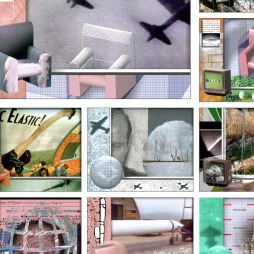| Paul Berger, Pictures |
|
CARD PLATES, 1998-99

Our current image landscape comes from a wide array of sources: photography, drawing, graphics, film, video and “synthetic” 2D & 3D digital imaging. These elements also reside together in a wide variety of formats and temporalities: prints, publications, movies, television, and software/website "interactivity". This density and blending of temporal and spatial landscaping is a reflection of the implosion of all image making systems currently underway within our culture with no clear end in sight. We must find a way to thrive, navigate, play, and stay up-right within the image world we have created and continue to expand. My work reflects this desire.
The Card Plates series, composed of fourteen 30” x 22” Iris prints, begins with the metaphor of the uncut press sheet, raw off the printing press. Each print has the dauntingly dense and composite look of a pre-signatured codex, before folding and gathering, or an open collection of parts that is simply pre-trimmed. This weaves a repetition and redundancy across a quasi narrative space: a cross between a mosaic and a comic strip. However, it is clear relatively soon that there is a basic card unit sub-structure to this image-wall, and that these sub-units are as much alike as they are distinct – like a deck of playing cards or a set of collector cards. The format in each card (there are 274 in total) reveals itself as composed of three picture spaces: one to the upper right which is larger and of photographic aspect ratio, one to the left which is a thin vertical, and one on the bottom right which is a long horizontal. At the juncture of all three is one of a small number of simple 3D image-wrapped objects: a board game-like “token” consisting of either a chair, a sphere, a book, a bowl or a television. The length and structure of the “deck” is only implied, as each sheet is uncut. It might be endless or partial, it might be complete but simply scrambled or shuffled, it might be like a card game which can never be won – or lost.
Paul Berger
December, 1999
The Card Plates series, composed of fourteen 30” x 22” Iris prints, begins with the metaphor of the uncut press sheet, raw off the printing press. Each print has the dauntingly dense and composite look of a pre-signatured codex, before folding and gathering, or an open collection of parts that is simply pre-trimmed. This weaves a repetition and redundancy across a quasi narrative space: a cross between a mosaic and a comic strip. However, it is clear relatively soon that there is a basic card unit sub-structure to this image-wall, and that these sub-units are as much alike as they are distinct – like a deck of playing cards or a set of collector cards. The format in each card (there are 274 in total) reveals itself as composed of three picture spaces: one to the upper right which is larger and of photographic aspect ratio, one to the left which is a thin vertical, and one on the bottom right which is a long horizontal. At the juncture of all three is one of a small number of simple 3D image-wrapped objects: a board game-like “token” consisting of either a chair, a sphere, a book, a bowl or a television. The length and structure of the “deck” is only implied, as each sheet is uncut. It might be endless or partial, it might be complete but simply scrambled or shuffled, it might be like a card game which can never be won – or lost.
Paul Berger
December, 1999
